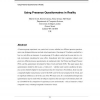PRESENCE
2000
14 years 2 months ago
2000
A between-group experiment was carried out to assess whether two different presence questionnaires can distinguish between real and virtual experiences. One group of 10 subjects s...
ETS
2000
IEEE
14 years 2 months ago
2000
IEEE
Practice has shown that providing content to students alone is not sufficient for good learning results. In computer based training (CBT) and especially webbased training (WBT) en...
CGF
2000
14 years 3 months ago
2000
In order to populate virtual cities, it is necessary to specify the behaviour of dynamic entities such as pedestrians or car drivers. Since a complete mental model based on vision...
VR
2008
IEEE
14 years 3 months ago
2008
IEEE
: The aim of all education is to apply what we learn in different contexts and to recognise and extend this learning to new situations. Virtual learning environments can used to bu...
TROB
2008
14 years 3 months ago
2008
Advanced, synthetic haptic virtual environments require textured virtual surfaces. We found that texturing smooth surfaces often reduces the system passivity margin of a haptic sim...
IJVR
2007
14 years 3 months ago
2007
—This article describes the design of the two application scenarios of the Virtual Human project and its integration into the Virtual Human system. This includes overall concepts...
PSYCHNOLOGY
2006
14 years 3 months ago
2006
Most of the Virtual Environments (VE) currently available in the field of psychological treatments are designed to solve a specific problem (acrophobia, flying phobia, claustropho...
MMS
2006
14 years 3 months ago
2006
This paper presents the design, implementation and evaluation of EVE Community Prototype, which is an educational virtual community aiming to meet the requirements of a Virtual Col...
JMM2
2006
14 years 3 months ago
2006
We propose algorithms and applications for using the hand as an interface device in virtual and physical spaces. In virtual drawing, by tracking the hand in 3D and estimating a vir...
ISM
2006
IEEE
14 years 3 months ago
2006
IEEE
Cooperative knowledge spaces create new potentials for the experimental fields in natural sciences and engineering because they enhance the accessibility of experimental setups th...






